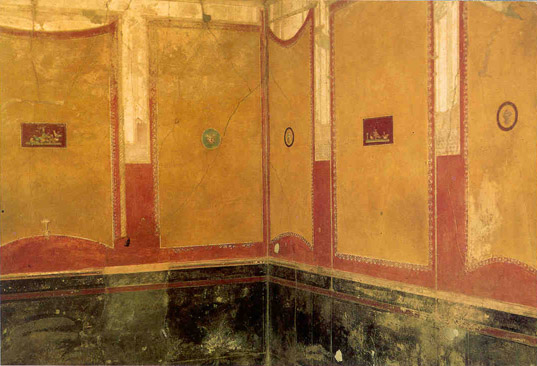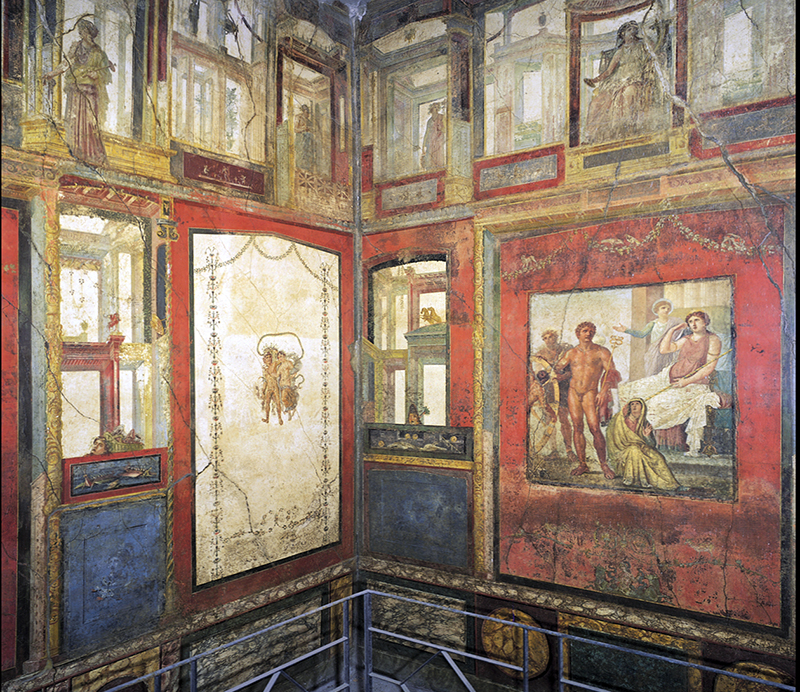Pompeii is well known for two things- primarily for its destruction by Mt. Vesuvius, but secondarily for it’s magnificent art, which includes some of the most well preserved art from Ancient Rome.
Classified by the German archeologist August Mau in the late 19th century, there are four categories of Pompeian art, each representing the time period that they came. However, before we get into what these styles may have looked like, it is important that we recognize that these styles of art were not limited to Pompeii itself, but rather encompassed the entirety of the Roman empire as a whole.

This first style of Pompeian art (pictured above), which Mau called the incrustation style, was characterized by faux marble in combination with other decorative elements, and the use of bright colors. This was done in order to give the impression of extravagance to visitors of the home, especially the cliens of the homeowner.
Said by Mau to have come from the 3rd century B.C., it is likely that Hellenistic culture influenced this style of art greatly, especially because this was also around the time that Rome was conquering much of the Greek/Hellenistic world. The first style survived and thrived from about 200 B.C. to 80 B.C., however, it’s influences were present in the later styles of Pompeian art as well, notably in the fourth style too.

The second style of Pompeian art classified by Mau was the illusionist style, where the paintings attempted to make the viewer essentially believe that they were looking through some sort of window or opening or door of some sort, giving the 2D wall a 3D look, thus in turn making the room seem much larger than it actually was. Again, much of this was done in order to increase the extravagance of the homes and show off the wealth of the owners.
Adding onto the illusions, the Romans used objects such as the Ionic columns you see in the mural above to give a sense of depth to the painting. Furthermore, objects in the distance tended to be more blurred as well, adding even more depth and realism to the images.

This third style of Pompeian art, pictured above (image of the House of Vetii, a very interesting place), had no illusionary tendencies to it. Rather, it was simple and monochromatic (A common pattern between artwork of the third style was things painted onto a monochromatic background, such as yellow in our case). Furthermore, the introduction of “zones” or “areas” was also added into this style of art, with approximately 3 vertical areas and 3-5 horizontal areas, which you can somewhat discern from the image above.
Although this style of architecture and art may seem more plain than the others so far, probably because it was, this simplicity may have been caused directly due to the over-complications of the more extravagant art of the second style.

Finally, this fourth style of Pompeian art (image above also from the house of Vetii), was more of a combination of the three previous styles of art. At the bottom of the image, we can see patterns of marble somewhat reminiscent of the first style, as well as tastes of the illusionary second style splashed throughout the painting. However, one thing distinctive of the fourth style not present in the rest of the styles is a sort of wall of framed scenes of sorts, such as the red frame around the scene on the right of the image.
Hopefully this was a much more interesting post, since I’m trying to improve my writing!
Cheers,
Parakeet!!!
Reblogged this on Die Goldene Landschaft.
LikeLike